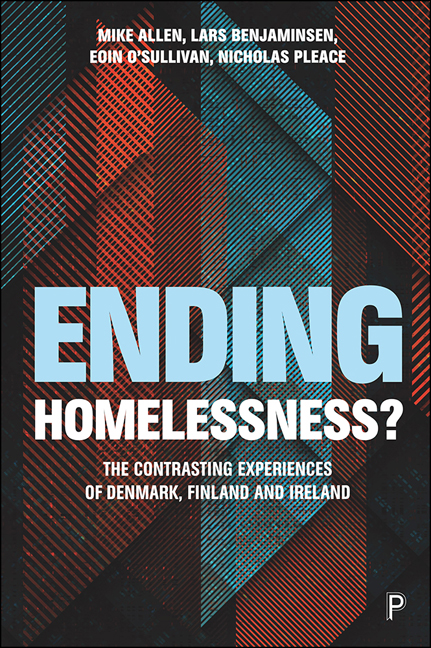Book contents
- Frontmatter
- Contents
- List of Figures and Tables
- Acknowledgements
- 1 Ending Homelessness? Policy and Progress in Denmark, Finland and Ireland
- 2 Before the Goal of ‘Ending Homelessness’: the Evolution of Policy
- 3 The Strategies Described
- 4 Trends in Homelessness in Denmark, Finland and Ireland
- 5 Explanations: Housing Matters
- 6 Explanations: Welfare and Politics Matter
- 7 Conclusion
- References
- Index
3 - The Strategies Described
Published online by Cambridge University Press: 25 February 2021
- Frontmatter
- Contents
- List of Figures and Tables
- Acknowledgements
- 1 Ending Homelessness? Policy and Progress in Denmark, Finland and Ireland
- 2 Before the Goal of ‘Ending Homelessness’: the Evolution of Policy
- 3 The Strategies Described
- 4 Trends in Homelessness in Denmark, Finland and Ireland
- 5 Explanations: Housing Matters
- 6 Explanations: Welfare and Politics Matter
- 7 Conclusion
- References
- Index
Summary
Introduction
The strategies of the three countries were published within a relatively short period of each other. The Finnish Strategy, Paavo I, was launched in February 2008, while the Irish national homeless strategy, entitled The Way Home: A Strategy to Address Adult Homelessness in Ireland, 2008– 2013, was launched in August 2008, and the Danish A Strategy to Reduce Homelessness in Denmark, 2009– 2012 was adopted in August 2007 and published in October 2009.
When considered in retrospect over the period 2008– 18, the three strategies can each be seen to have distinct phases of announcement and implementation. In the case of the Finnish strategies, these build upon each other through a series of achievements and refined objectives, while in the Irish case, the strategies change considerably in format and scope, reflecting the broader economic and political crisis that engulfed the country. The development of the Danish strategy falls in between the other two cases.
The initial strategies
The Danish homelessness strategy
In Denmark, following the first homelessness count in 2007, a national homelessness strategy was adopted by the Danish government. The strategic programme succeeded earlier programmes aimed at strengthening social services for marginalised groups. For instance, the City Programme (Storbypuljen) from 2003 to 2005 also involved initiatives for homeless people, as well as services for other marginalised groups. At the same time, the strategy built on top of existing services in the general welfare system.
Four overall goals were set in the programme and operational targets attached to each goal were set at the local level. The four goals were:
1. to reduce rough sleeping;
2. to provide solutions other than shelters to homeless youth;
3. to reduce time spent in a shelter; and
4. to reduce homelessness due to institutional release from prison and hospitals without a housing solution.
A range of services for homeless people, and vulnerable people in general, was already specified in social services legislation. In particular, section 110 in the legislation obliges municipalities to provide temporary accommodation for people who have no place to live or who cannot stay at the place where they live due to social problems. About 70 homeless shelters nationwide operate under this section of the law.
- Type
- Chapter
- Information
- Ending Homelessness?The Contrasting Experiences of Denmark, Finland and Ireland, pp. 47 - 72Publisher: Bristol University PressPrint publication year: 2020



